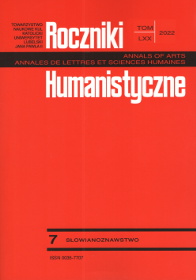«Слово» и «дело» преподобного Паисия Величковского: к 300-летию со дня рождения подвижника
The “Word” and “Deed” of St. Paisius Velichkovsky: On the 300th Anniversary of the Ascetic’s Birth
Author(s): Vladimir KrivolapovSubject(s): Language and Literature Studies, Studies of Literature, Russian Literature
Published by: Towarzystwo Naukowe KUL & Katolicki Uniwersytet Lubelski Jana Pawła II
Keywords: split; books; asceticism; life; autobiography; monastery; Moldavia; Polish-Lithuanian Commonwealth; adventure novel
Summary/Abstract: By the 19th century, the paths of Europeanised, secular Russia and the people’s “Holy Russia” had finally diverged. Nikolai Berdyaev reasoned that Seraphim of Sarov and Alexander Pushkin were contemporaries, but did not know about each other as they lived in separate worlds, that of literature and that of holiness. However, at the same time, in the second half of the 18th century in the monasteries of Moldavia, there was a man about whom Pushkin almost certainly heard and whose writings were carefully read by St. Seraphim. His name was Paisius Velichkovsky (1722-1794) and in his work he outlined ways to overcome the “split” that had taken place. The disciples of Paisius found refuge in Russian monasteries, his writings and translations of patristic texts enjoyed exceptional popularity among the monastic community, and his successors revived the phenomenon of the Optina eldership, as a result of which almost all literary classic writers from Gogol to Prishvin visited the Optina Monstery. The author of this article is primarily interested in Paisius as the author of his own biography. In addition to this text, there are several versions of the life of this ascetic, composed either by his disciples or by the disciples of his disciples. The autobiography does not resemble a life at all; in terms of genre, it is rather an adventure novel, whereas the life of Paisius, written by his disciple Mitrofan, fully corresponds to the hagiographic canon. The Paisian texts, combined into a single corpus, give an idea not only about the personality of the ascetic, but also about the meeting of two literary systems: that which still gravitated towards the traditions of the Middle Ages, and that which was inspired by the Early Modern Period. The personality of Paisius harmoniously combined those features traditional for an ascetic monk (a reference figure for the Russian Middle Ages), and those that revealed in him a dynamic 18th century man. The author of this article is convinced that not only the legacy of Saint Paisius, but also his image, is the embodied answer to the question of how to overcome the “split”.
Journal: Roczniki Humanistyczne
- Issue Year: 70/2022
- Issue No: 7
- Page Range: 309-324
- Page Count: 16
- Language: Russian

